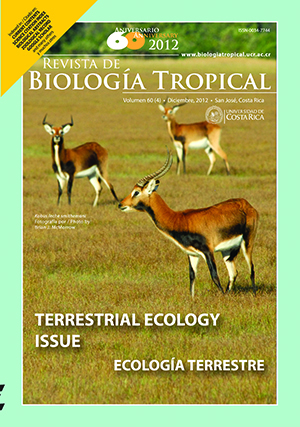Resumen
La destrucción de los bosques naturales se está incre- mentando debido a la urbanización y la industrialización, así como por la expansión agrícola en las últimas décadas, por lo tanto deben llevarse a cabo los respectivos estu- dios para su recuperación. Este estudio comparativo fue diseñado para ver los efectos de la tierra deforestada en la germinación y crecimiento de cinco especies diferentes de árboles. Las especies Gmelina arborea, Swietenia maha- goni, Dipterocarpus turbinatus, Acacia auriculiformis y Syzygium grande fueron germinadas por seis semanas en semilleros y criadas en macetas que se llenaron con dos tipos de tierra: de los bosques deforestados y los adyacen- tes de Dulhazara Safari Park. El crecimiento de plántulas se observó por 15 meses basándose en altura, diámetro del cuello y producción de biomasa. La tasa de germinación fue casi similar en ambos tipos de tierra. El crecimiento en altura de plántulas de D. turbinatus, G. arborea y S. maha- goni fue casi similar y para A. auriculiformis y S. grande fue menor en el suelo deforestado en comparación con el bosque, mientras que el diámetro del cuello de A. auricu- liformis, G. arborea, S. grande y S. mahagoni fue inferior y D. turbinatus similar en la tierra deforestada comparada con la del bosque. Después de arrancar de raíz a los 19 meses, S. mahagoni mostró mayor biomasa seca, así como D. turbinatus y A. auriculiformis, mientras que G. arborea mostró ser más baja y S. grande casi similar en ambos tipos de suelo. Las diferencias en la tasa de germinación y de crecimiento para diferentes especies de árboles indica que el suelo no está muy deteriorado por la deforestación en Dulhazara y sin fallar esas tierras deforestadas podrían ser restauradas a través de la plantación.Descargas
Los datos de descargas todavía no están disponibles.

